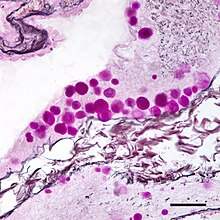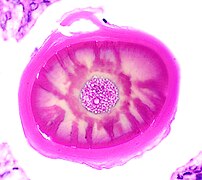146:
134:
50:
27:
88:, and sometimes in other organs of the body. Corpora amylacea increase in number and size with advancing age, although this increase varies from person to person. In the nervous system, they are particularly abundant in certain
133:
95:
The composition and appearance of corpora amylacea can differ in different organs. In the prostate gland, where they are also known as prostatic concretions, corpora amylacea are rich in aggregated
145:
175:
Röcken C, Linke RP, Saeger W (October 1996). "Corpora amylacea in the lung, prostate and uterus. A comparative and immunohistochemical study".
92:. While their significance is largely unknown, some researchers have suggested that corpora amylacea play a role in the clearance of debris.
332:"Corpora amylacea in human hippocampal brain tissue are intracellular bodies that exhibit a homogeneous distribution of neo-epitopes"
127:. Polyglucosan bodies bearing at least partial resemblance to human corpora amylacea have been observed in various nonhuman species.
107:
are generally smaller and do not contain amyloid. Corpora amylacea in the central nervous system occur in the foot processes of
89:
104:
54:
343:
228:
58:
139:
Natural luminescence of corpora amylacea in the lumen of the prostate in ultraviolet light
8:
347:
232:
364:
331:
312:
249:
216:
116:
300:
287:
Cavanagh JB (April 1999). "Corpora-amylacea and the family of polyglucosan diseases".
188:
398:
369:
304:
254:
192:
316:
123:
diseases, in which polymers of glucose collect to form abnormal structures known as
393:
359:
351:
296:
244:
236:
184:
20:
49:
403:
355:
330:
Augé E, Bechmann I, Llor N, Vilaplana J, Krueger M, Pelegrí C (February 2019).
81:
77:
119:, and around blood vessels. They have been proposed to be part of a family of
53:
Micrograph of corpora amylacea (purple spheres) in the brain of a person with
387:
72:) (from the Latin meaning "starch-like bodies") is a general term for small
26:
373:
308:
258:
120:
42:
196:
108:
30:
240:
112:
38:
100:
96:
73:
124:
151:
Histology of a multilayered corpus amylaceous of the prostate.
215:
Augé E, Cabezón I, Pelegrí C, Vilaplana J (February 2017).
214:
85:
329:
217:"New perspectives on corpora amylacea in the human brain"
61:
and silver stains. Bar = 50 microns (0.05 millimeters).
174:
385:
16:Name for a variety of small anatomical masses
111:, and they are usually present beneath the
282:
280:
278:
276:
274:
272:
270:
268:
363:
248:
286:
170:
168:
166:
48:
25:
265:
386:
289:Brain Research. Brain Research Reviews
210:
208:
206:
163:
323:
203:
13:
14:
415:
115:, in the tissues surrounding the
99:that has many of the features of
177:Pathology, Research and Practice
144:
132:
1:
301:10.1016/S0165-0173(99)00003-X
189:10.1016/S0344-0338(96)80041-0
156:
7:
10:
420:
356:10.1038/s41598-018-38010-7
90:neurodegenerative diseases
18:
19:Not to be confused with
103:, whereas those in the
105:central nervous system
62:
46:
52:
29:
76:masses found in the
59:Periodic acid-Schiff
348:2019NatSR...9.2063A
233:2017NatSR...741807A
125:polyglucosan bodies
55:Alzheimer's disease
336:Scientific Reports
221:Scientific Reports
63:
47:
241:10.1038/srep41807
411:
378:
377:
367:
327:
321:
320:
295:(2–3): 265–295.
284:
263:
262:
252:
212:
201:
200:
183:(10): 998–1006.
172:
148:
136:
66:Corpora amylacea
39:prostatic glands
35:corpora amylacea
21:Corpora arenacea
419:
418:
414:
413:
412:
410:
409:
408:
384:
383:
382:
381:
328:
324:
285:
266:
213:
204:
173:
164:
159:
152:
149:
140:
137:
24:
17:
12:
11:
5:
417:
407:
406:
401:
396:
380:
379:
322:
264:
202:
161:
160:
158:
155:
154:
153:
150:
143:
141:
138:
131:
82:nervous system
78:prostate gland
15:
9:
6:
4:
3:
2:
416:
405:
402:
400:
397:
395:
392:
391:
389:
375:
371:
366:
361:
357:
353:
349:
345:
341:
337:
333:
326:
318:
314:
310:
306:
302:
298:
294:
290:
283:
281:
279:
277:
275:
273:
271:
269:
260:
256:
251:
246:
242:
238:
234:
230:
226:
222:
218:
211:
209:
207:
198:
194:
190:
186:
182:
178:
171:
169:
167:
162:
147:
142:
135:
130:
129:
128:
126:
122:
118:
114:
110:
106:
102:
98:
93:
91:
87:
83:
79:
75:
71:
67:
60:
56:
51:
44:
43:H&E stain
40:
36:
32:
28:
22:
339:
335:
325:
292:
288:
224:
220:
180:
176:
121:polyglucosan
94:
69:
65:
64:
34:
342:(1): 2063.
57:. Combined
388:Categories
157:References
117:ventricles
109:astrocytes
37:in benign
31:Micrograph
227:: 41807.
113:pia mater
399:Prostate
374:30765834
317:24609073
309:10209236
259:28155917
394:Anatomy
365:6375970
344:Bibcode
250:5290524
229:Bibcode
197:8958549
101:amyloid
97:protein
74:hyaline
372:
362:
315:
307:
257:
247:
195:
404:Brain
313:S2CID
370:PMID
305:PMID
255:PMID
193:PMID
86:lung
360:PMC
352:doi
297:doi
245:PMC
237:doi
185:doi
181:192
33:of
390::
368:.
358:.
350:.
338:.
334:.
311:.
303:.
293:29
291:.
267:^
253:.
243:.
235:.
223:.
219:.
205:^
191:.
179:.
165:^
84:,
80:,
70:CA
41:.
376:.
354::
346::
340:9
319:.
299::
261:.
239::
231::
225:7
199:.
187::
68:(
45:.
23:.
Text is available under the Creative Commons Attribution-ShareAlike License. Additional terms may apply.



